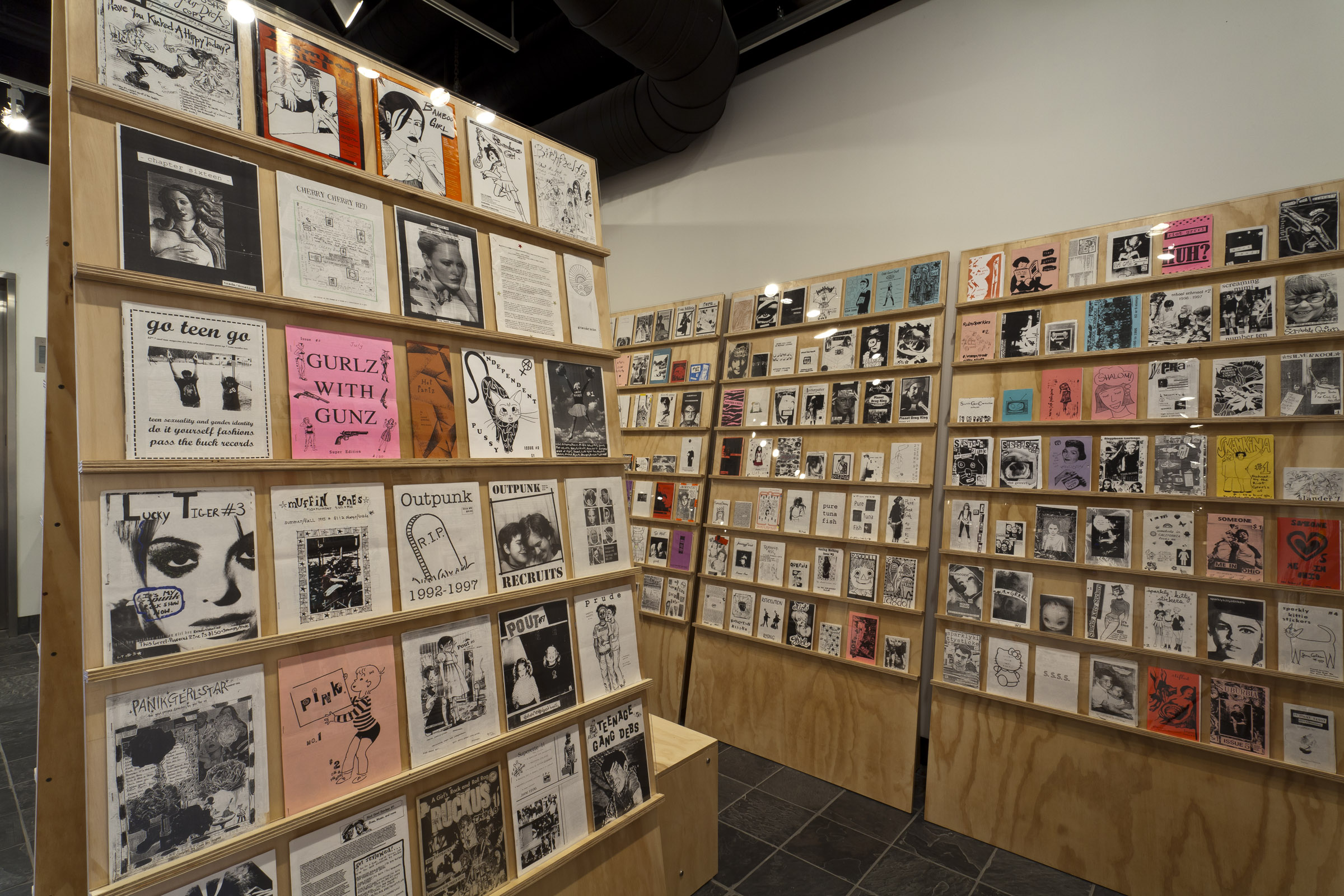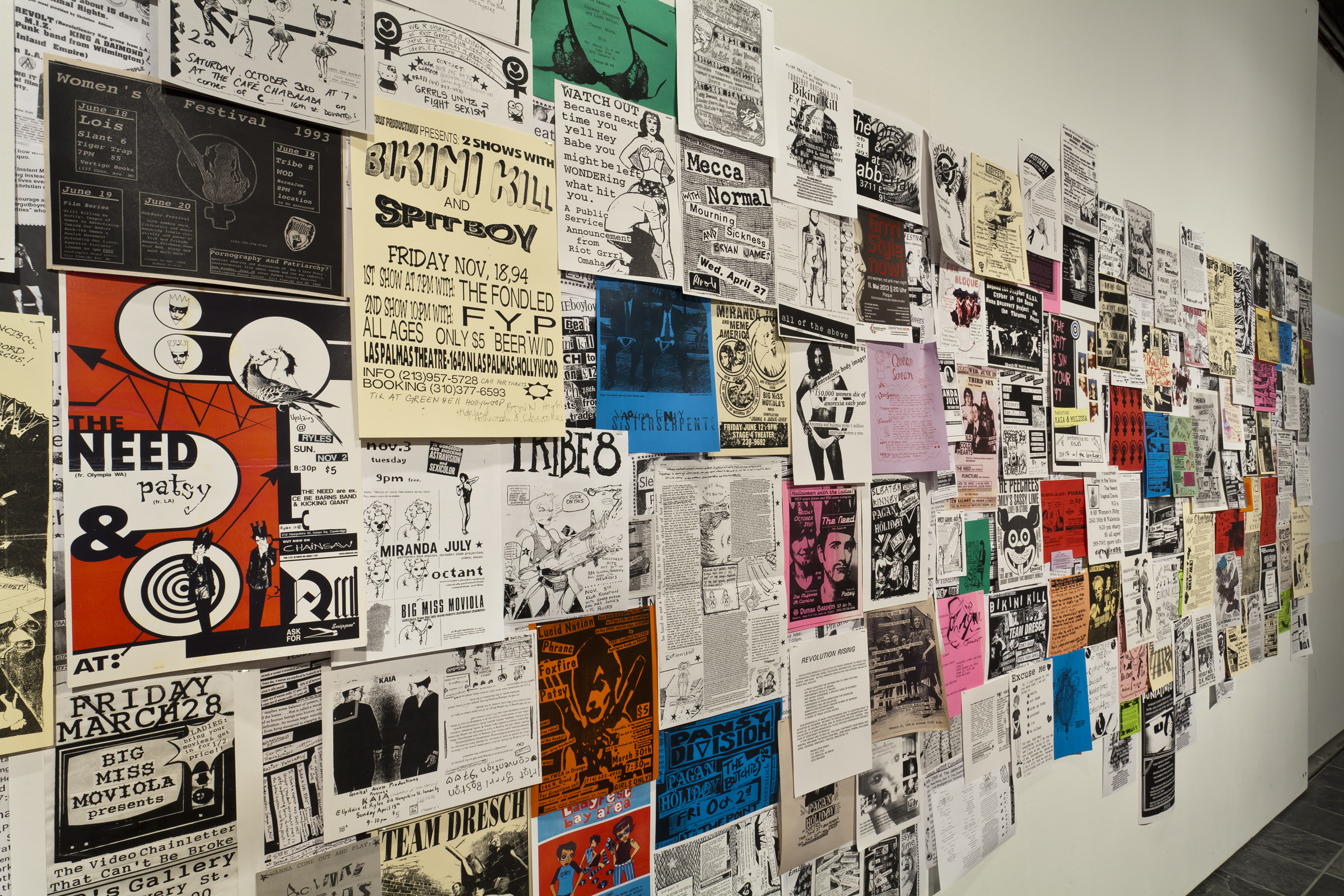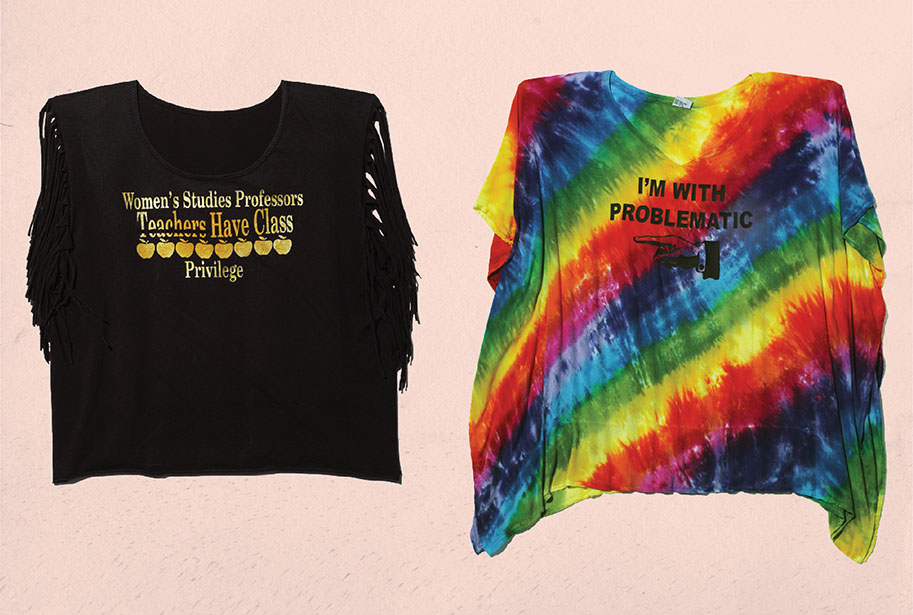
Women’s Studies Professors Have Class Privilege / I’m With Problematic, from the series Creep Lez, Allyson Mitchell, 2012
Altered t-shirts with iron-on transfer and vinyl letters. Courtesy of the artist and Katharine Mulherin Gallery, Toronto.
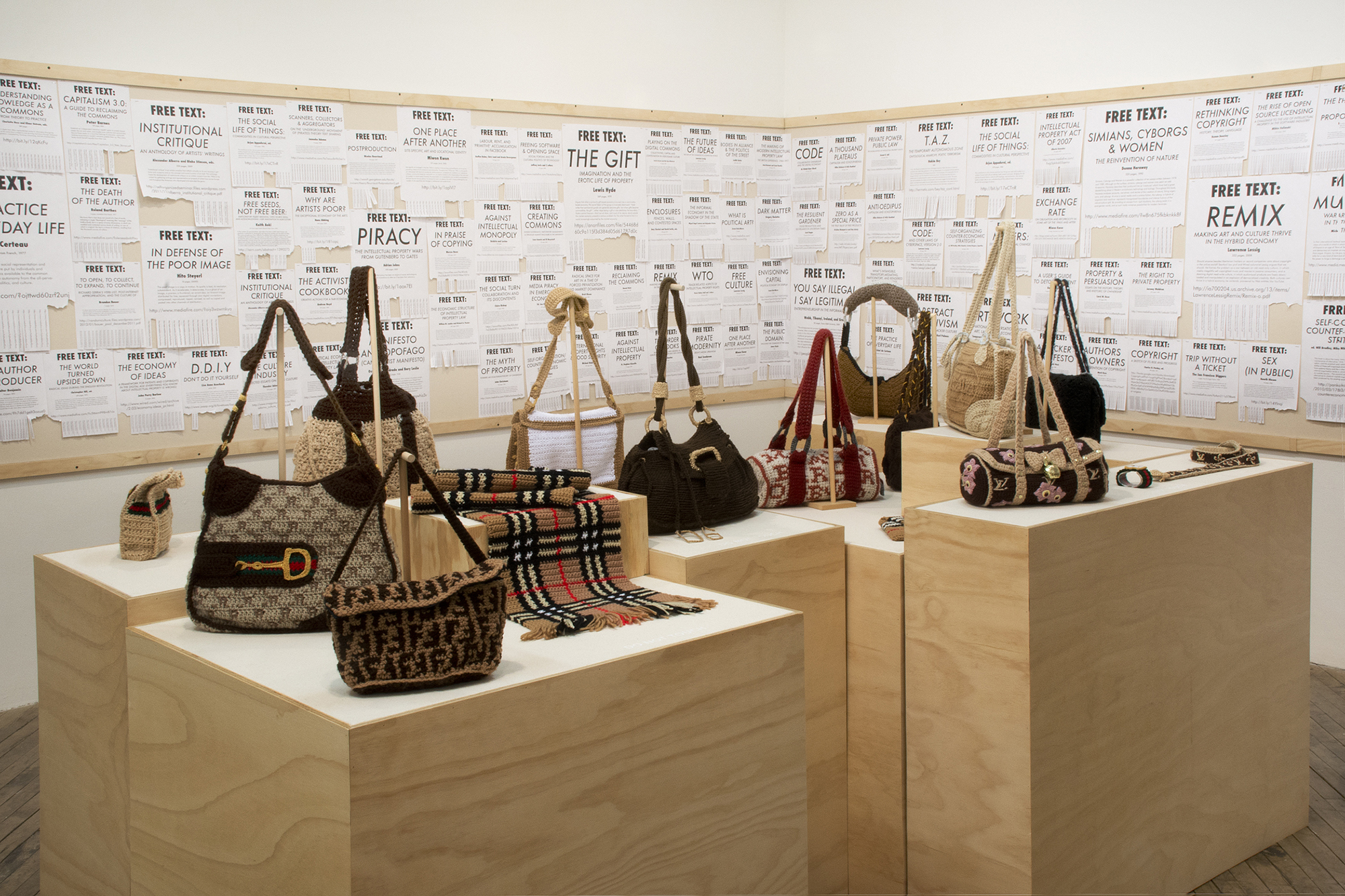
Alien She exhibition at Vox Populi, Philadelphia: The Counterfeit Crochet Project (Critique of a Political Economy) (2006-ongoing); Yarn, downloadable PDF instructional guide for creating knockoff logos. By Stephanie Syjuco and courtesy of the artist and Catharine Clark Gallery, San Francisco. Images courtesy of Vox Populi
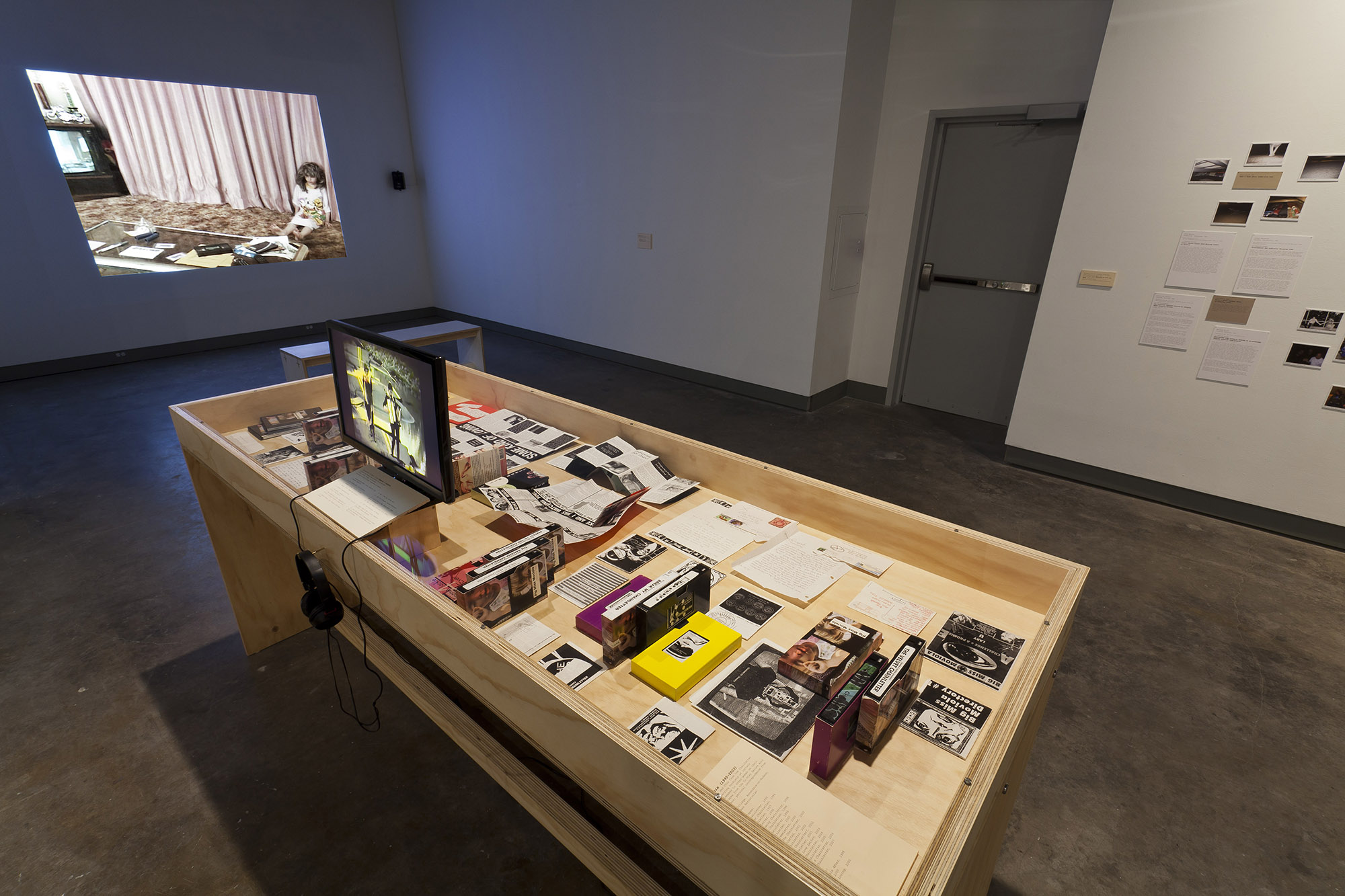
dwnldInstallation shot: Foreground: Joanie 4 Jackie (1995-2003); VHS masters, tapes and DVDs from the Chainletter Series with accompanying booklets of letters written by each filmmaker to other women on their compilation, VHS tapes from the Co-Star Series with accompanying posters, personal correspondence from July’s collection; Courtesy of the artists and Bard College, Annandale-on-Hudson. Background: Videos (1996-2001) by July; Single-channel video with sound, 57:30 minutes; Courtesy of the artist and Video Data Bank, Chicago. Learning To Love You More (2002-2009) by Miranda July and Harrell Fletcher, with website by Yuri Ono; Exhibition prints from web project and archive; Courtesy of the San Francisco Museum of Modern Art.
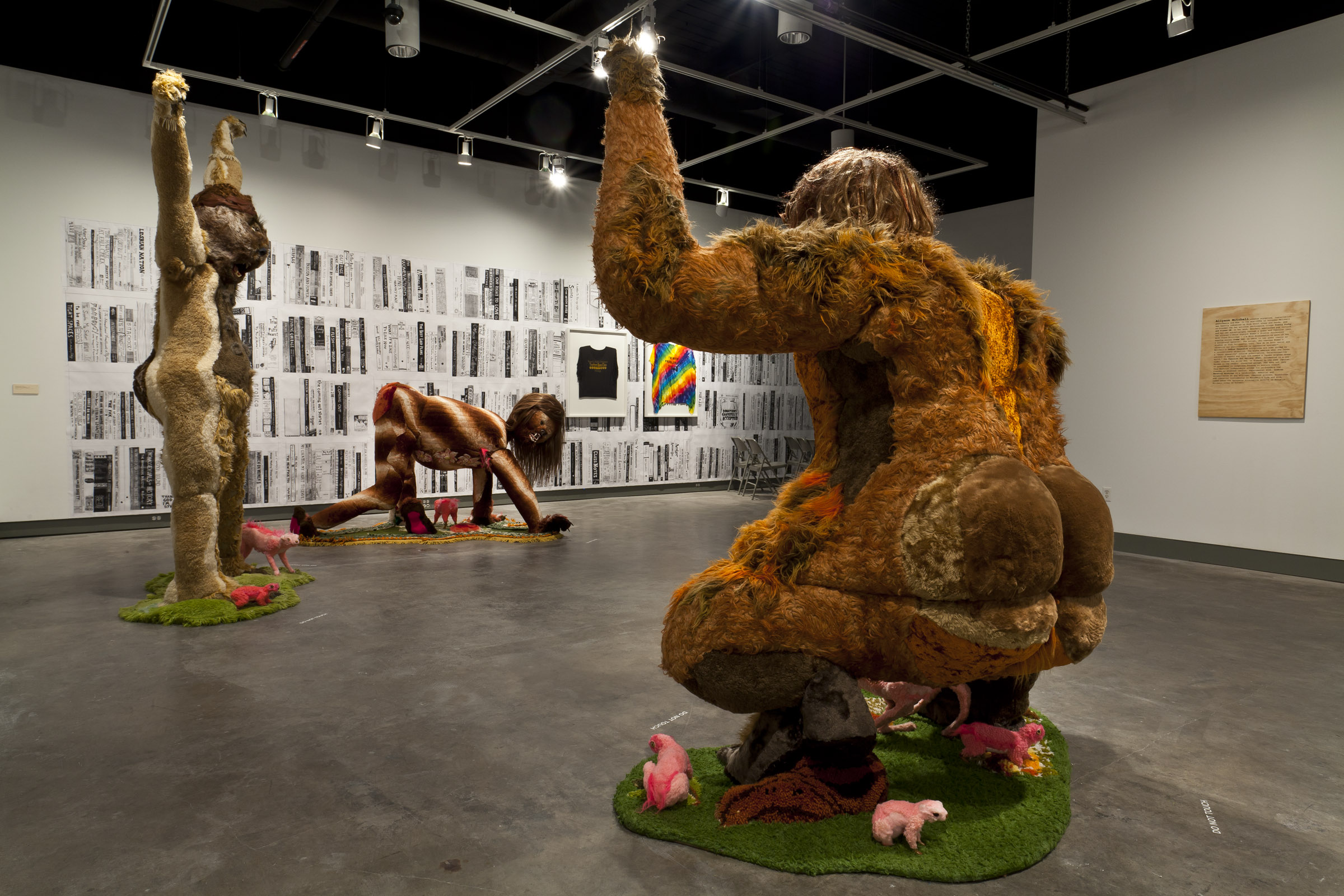
Installation shot: Foreground: Ladies Sasquatch (2006-2010); Found textiles, taxidermy supplies, appliqué borg, styrofoam, wood. Recommended Reading (2010); Wallpaper of photocopied drawings. Both by Allyson Mitchell and courtesy of the artist and Katharine Mulherin Gallery, Toronto.
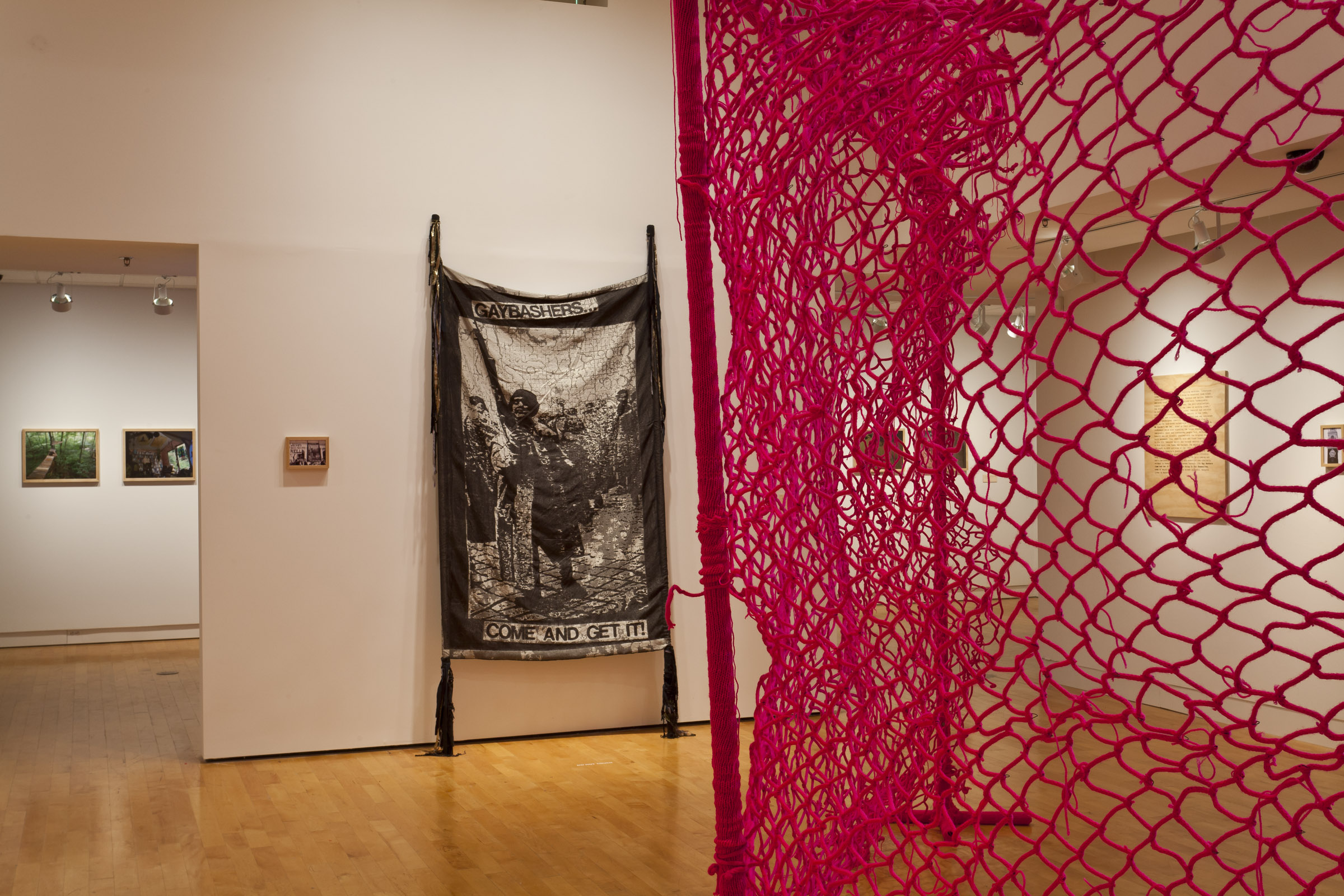
Installation shot: Foreground: We Couldn’t Get In. We Couldn’t Get Out. (2006-2007); Crank-knit yarn, hand-woven wire, steel poles. Midground: Gay Bashers Come And Get It (2011); Jacquard-woven cotton and lurex, hand-dyed fabric, crank-knit yarn, thread. Graphic appropriated from a poster designed by Matt Height, silkscreened at Queeruption (1999) at DUMBA, Brooklyn, and used as an album insert for queercore band Limp Wrist. Both by L.J. Roberts and courtesy of the artist.
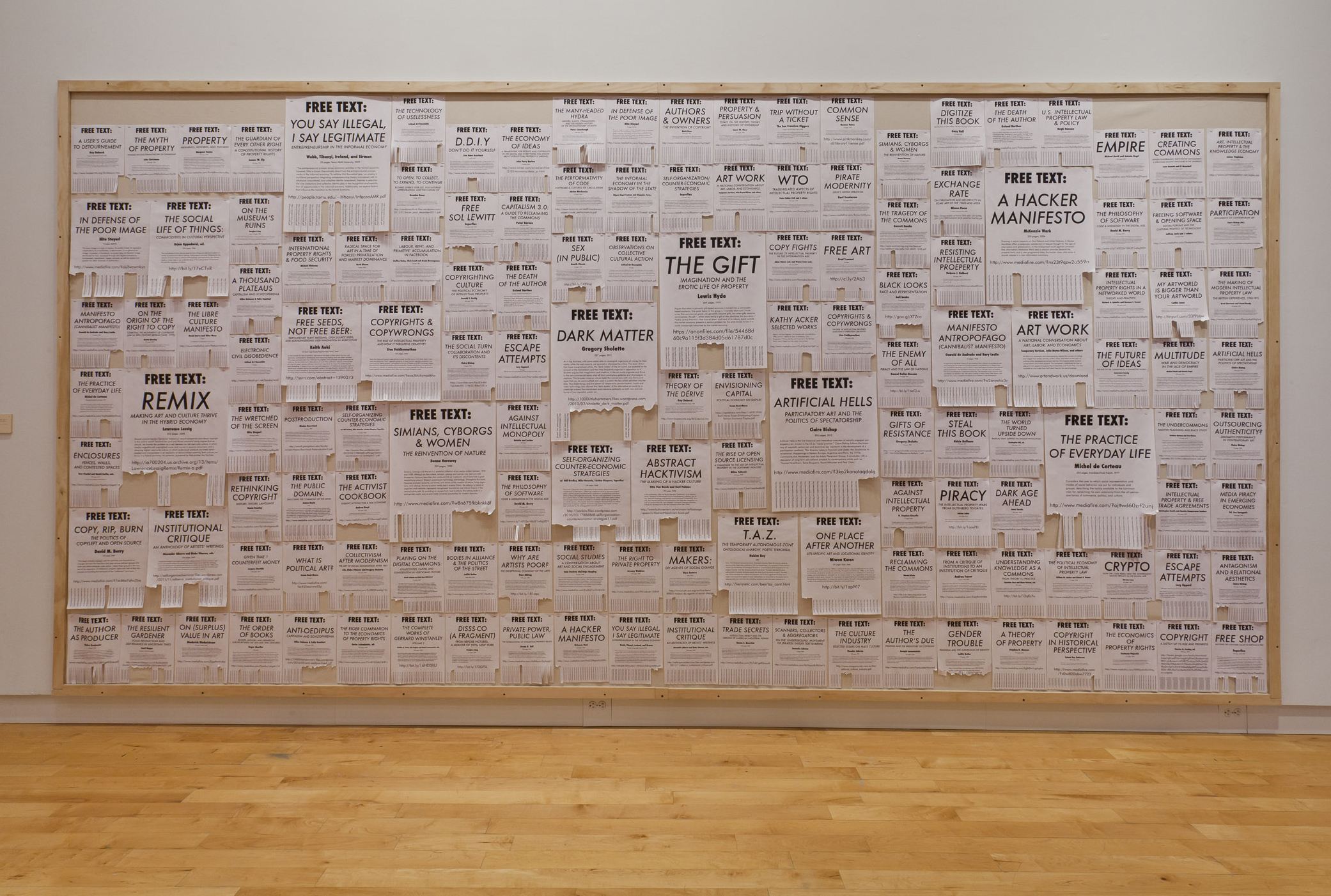
Installation shot: FREE TEXTS (2011-2012, updated 2013); Free downloadable PDF files of texts found online and tear-off tab flyers. By Stephanie Syjuco and courtesy of the artist and Catharine Clark Gallery, San Francisco. This project was updated for Alien She, and includes texts selected by the artists in the exhibition.
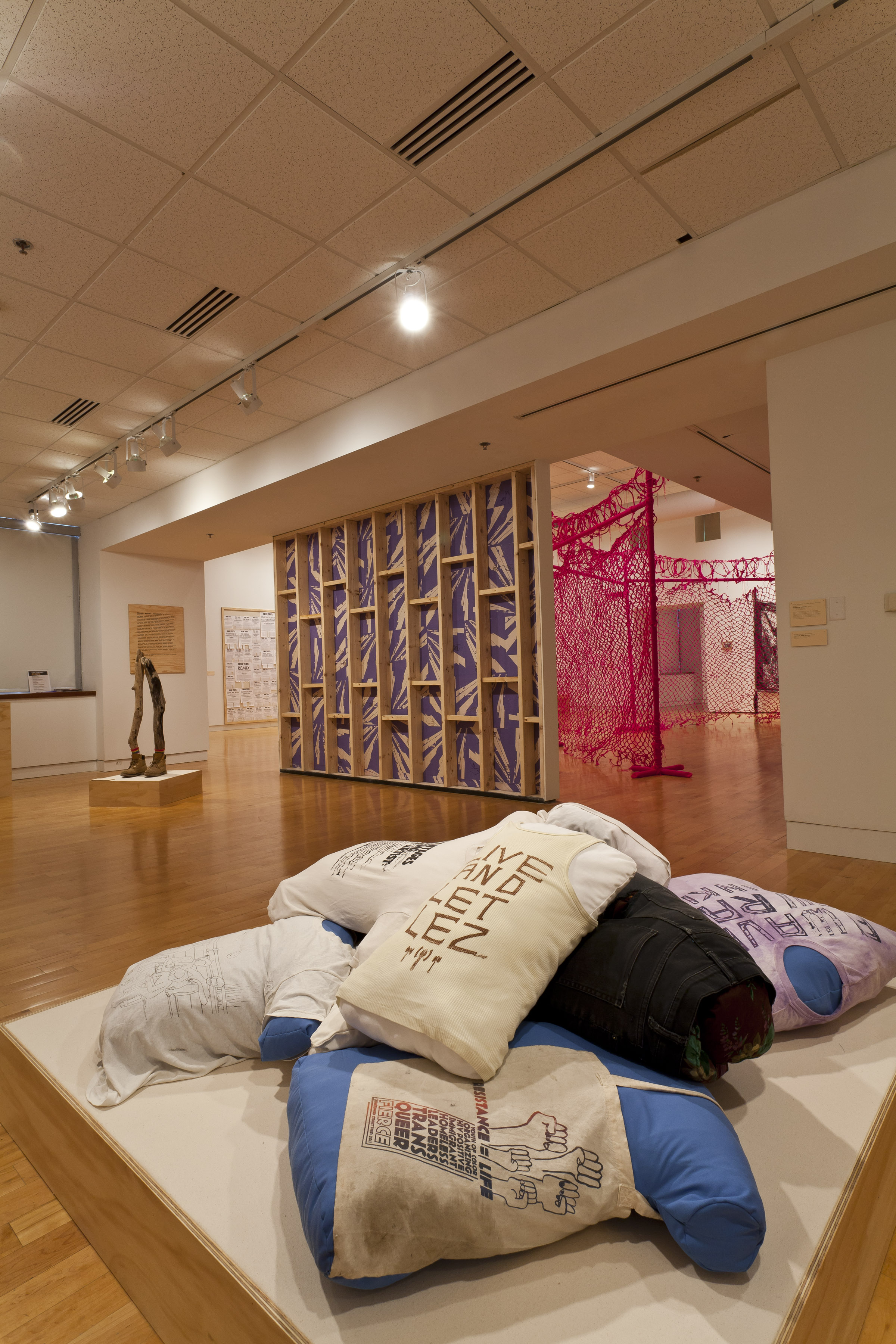
Installation shot: Foreground: Feminist Body Pillow (2013); Hand printed t-shirts, jeans (tote bag made in a screenprinting workshop led by the artist at Fabulous Independent Educated Radicals for Community Empowerment (FIERCE); Julius Bootleg t-shirt and Live And Let Lez tank top by the artist; t-shirt (rainbow fist) by Dean Daderko;
A Wave of New Rage Thinking t-shirt by LTTR; The Advantages of Being a Lesbian Artist t-shirt by Ridykeulous; Gay Power sweatshirt by Emily Roysdon). By Ginger Brooks Takahashi and courtesy of the artist.
Alien She
- VENUES Miller Gallery at Carnegie Mellon University, Vox Populi, Yerba Buena Center for the Arts, Orange County Museum of Art, Pacific Northwest College of Art: Feldman Gallery & Project Space
- LOCATIONS Pittsburgh, PA, Philadelphia, PA, San Francisco, CA, Newport Beach, CA and Portland, OR
- DATES Touring Sept. 2013-November 2015
- URL cmu.edu
- BROCHURE cecimoss.com
- PRESS https://cecimoss.com/wp-content/uploads/2016/03/Alien She_YBCA_Press.pdf
Touring group exhibition co-curated by Astria Suparak and Ceci Moss.
Artists Ginger Brooks Takahashi (Pittsburgh), Tammy Rae Carland (Oakland), Miranda July (Los Angeles), Faythe Levine (Milwaukee), Allyson Mitchell (Toronto), L.J. Roberts (Brooklyn), Stephanie Syjuco (San Francisco)
Description Alien She is the first exhibition to examine the lasting impact of Riot Grrrl on artists and cultural producers working today. A pioneering punk feminist movement that emerged in the early 1990s, Riot Grrrl has had a pivotal influence, inspiring many around the world to pursue socially and politically progressive careers as artists, activists, authors and educators. Emphasizing female and youth empowerment, collaborative organization, creative resistance and DIY ethics, Riot Grrrl helped a new generation to become active feminists and create their own culture and communities that reflect their values and experiences, in contrast to mainstream conventions and expectations.
Riot Grrrl formed in reaction to pervasive and violent sexism, racism and homophobia in the punk music scene and in the culture at large. Its participants adapted strategies from earlier queer and punk feminisms and ‘70s radical politics, while also popularizing discussions of identity politics occurring within academia, but in a language that spoke to a younger generation. This self-organized network made up of teenagers and twenty-somethings reached one another through various platforms, such as letters, zines, local meetings, regional conferences, homemade videos, and later, chat rooms, listservs and message boards. The movement eventually spread worldwide, with chapters opening in at least 29 states and 21 countries.* Its ethos and aesthetics have survived well past its initial period in the ‘90s, with many new chapters forming in recent years. Riot Grrrl’s influence on contemporary global culture is increasingly evident – from the Russian collective Pussy Riot’s protest against corrupt government-church relations to the popular teen website Rookie and the launch of Girls Rock Camps and Ladyfest music and art festivals around the world.
Alien She focuses on seven people whose visual art practices were informed by their contact with Riot Grrrl. Many of them work in multiple disciplines, such as sculpture, installation, video, documentary film, photography, drawing, printmaking, new media, social practice, curation, music, writing and performance – a reflection of the movement’s artistic diversity and mutability. Each artist is represented by several projects from the last 20 years, including new and rarely seen works, providing an insight into the development of their creative practices and individual trajectories.
In various ways, these artists have incorporated, expanded upon, or reacted to Riot Grrrl’s ideology, tactics and aesthetics. For instance, many continue to cultivate and nurture alternative communities. Ginger Brooks Takahashi creates spaces for conversation and exchange with jubilant publications, dance parties, mobile reading rooms and soup delivery service. Through photography and video, Faythe Levine documents groups committed to DIY independence and handmade aesthetics, such as crafters, off-the-gridders, and, in her new book and documentary, traditional hand-lettered sign painters. L.J. Roberts fabricates declarations of protest and solidarity with evocative banners and textile works.
Riot Grrrl thrived through the establishment of DIY networks and information sharing, an aspect manifest in Stephanie Syjuco’s project for freely distributing copyrighted critical texts and in Miranda July’s video chainletter for “lady moviemakers.” Recalling forgotten her/histories was also central to Riot Grrrl, and in that vein, Allyson Mitchell pays homage to key writings, feminist presses, bookstores and libraries with lesbian feminist library wallpaper, while Tammy Rae Carland reveals intimate relationships in her autobiographical photo series. All of the artists included here have worked collaboratively and many have built platforms for other artists and under-recognized groups to connect, encourage, share resources and self-publish.
The exhibition’s historical section is designed to be plural and open-ended; this is a living history, not a sealed past. By representing numerous voices and experiences, rather than outlining one single definitive story, we hope it will reflect the multiplicity that was such an integral part of the original movement. Toward this end, a sampling of the Riot Grrrl movement’s vast creative output is included here. Hundreds of self-published zines and hand-designed posters were solicited from institutional and personal archives through open calls, word-of-mouth and invitations – similar to the way Riot Grrrl expanded. Music playlists represent different Riot Grrrl scenes across the U.S., Canada, South America and Europe, guest curated by musicians, DJs and label owners, and accompanied by records, cassettes, set lists, band T-shirts and other ephemera. Video interviews and an ongoing, online Riot Grrrl Census provide an expanded oral history.
The exhibition’s title, Alien She, is a reference to a Bikini Kill song of the same name. The lyrics are about the negotiation of normalized gender roles, the uneasy line between feminist critique and collectivity, and the process of coming to a feminist consciousness, with the repeated refrain, “She is me, I am her.” More broadly, Alien She conjures the possibilities of identity, self-determination and subversion. In the face of alienation and bigotry, Riot Grrrl fostered community, action and creation. This exhibition provides a view into the passion and diversity of the original Riot Grrrl movement, and highlights how these ideas have broadened, evolved and mutated in the work of contemporary artists.
TOUR
Sept. 21, 2013 – Feb. 16, 2014
Miller Gallery at Carnegie Mellon University, Pittsburgh, PA
March 7 – April 27, 2014
Vox Populi, Philadelphia, PA
Oct. 24, 2014 – Jan. 25, 2015
Yerba Buena Center for the Arts, San Francisco, CA
Feb. 13 – May 17, 2015 (tbc)
Orange County Museum of Art, Newport Beach, CA
Sept. 3 – Nov. 27, 2015
Pacific Northwest College of Art: Feldman Gallery & Project Space, Portland, OR

